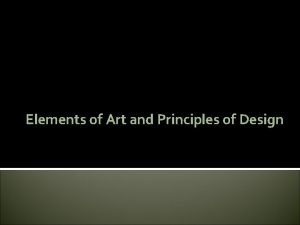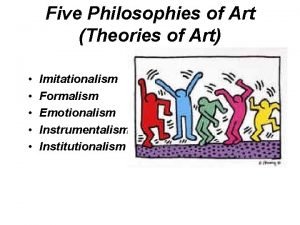Responding to Artwork Classroom Discussion Students love conversation

















- Slides: 17

Responding to Artwork

Classroom Discussion • Students love conversation, if they feel safe. – Not looking for a “right” answer. – Other students will respect their opinion. • Not all students will know how to participate in a discussion. • Teachers need lots of good questions to get good discussion.

Some Pro Social Skills • • • Showing signs of listening. Encourage someone to elaborate on his or her comments. Express interest in someone’s comments Encourage someone to elaborate on his or her comments Explain a link between the comments of two people Make a contribution that builds on someone’s comment Paraphrase someone’s comment Summarize several comments Ask a cause and effect question Ask for time to think about a comment Express appreciation for what you’ve gained from the discussion Disagree with a comment in a respectful and constructive way

Components of Pro Social Skill • Listening – Start with an open mind. – Try to understand the context. • Are they just venting or do they want to change something? • Do they want you to do something? If so, what? – Use follow up questions like • And? • Why? • How? – Use body language. • Nod • Lean forward • Maintain eye contact – Paraphrase to help understanding • "So what you are saying is. . . "

Teach the Strategy • Explicitly explain outline the characteristics – You teach – Students help generate ideas. Ask “what does listening look like? ” • Model the strategy. • Practice the strategy. – Role play – Fish Bowl Technique – Group/self/teacher assessed • Independent Practice – Provide structured opportunities for students to talk.

Ideas for Structured Discussion • Sentence completion: – What impressed me most about the reading for today was… – The question I’d most like to ask the author is… – The idea in the reading that I most disagree with is…

Ideas for Structured Discussion • Discussion Roles – Problem, dilemma or theme poser: • Introduces the topic of conversation – Reflective analyst: • Records the conversation’s flow, offering a periodic summary – Scrounger: • Listens for suggestions and needs, records them and reviews them at the end of the discussion so the group may decide an action plan – Devil’s advocate: • Expresses a contrary view to group consensus – Detective: • Listens for unexplored biases, and brings attention to them – Theme spotter: • Identifies themes needing time at the next session – Umpire: • Listens for personal judgments in order to enforce ground rules

Responding to Artwork • Hamburger Rule – start with something good – problem/concern/criticism – end with something good. • Critique Generation • Know Nothing Boobs • Dali

Responding to Art • Description – Just as it says, first you describe the facts, including the name of the work, artist, medium, etc. – What does the art look like, what is it made of, what objects do you see in it? – What textures, shapes, or colors are there?

Responding to Art In this painting, I see butterflies There are two of them, and they are in flight with their wings open. I also see what appears to be the side of a cliff, or a flat wall that has been broken off. It is daytime because the sky is blue, but there is also another drastic light-source coming from the right side, creating harsh shadows. The landscape appears to be outdoors, because of the sky and because of the vast desert in the distance. The colors are very intense, especially the blue and the orange. There is a strong contrast between light and dark, and overall, the lines are very defined. The viewer is either very close in proximity to the butterflies, or the butterflies are rather large. As the viewer, we appear to be standing in front of this scene, looking straight at it, and the overall effect is realism.

Responding to Art • Analysis – Tell how all the answers from the description you just made are related to each other. – A good suggestion is to think about some of the “principles” of art: • • • movement (or rhythm), variety, proportion, emphasis, balance, contrast.

Responding to Art As I view this piece, my eyes are occasionally led over to the vanishing point on the left (in the distance), but keep coming back to the focal point around the butterflies. This movement happens largely because of the shadow that the rock casts in that direction. The blue of the sky and the orange of the rock are very intense and bright (highly saturated), and their opposition with each other also contributes to the back and forth motion of our eyes as we view the painting. If the blue color was not as saturated, more focus would be on the right side of the painting, it would have too much “weight, ” and our eyes would linger there more. As a result, the painting’s composition would be less balanced.

Responding to Art • Interpretation – how does the painting make you feel? – What does it make you think of? – What do you think the artist is trying to communicate to you as a viewer? • Judgement – Is it a success or a failure in your opinion? – Do you feel it is original or not original? – Would you hang it on your wall at home?

Interpretation I don’t feel either sad or happy when looking at this…The colors are nice ‘n bright, and butterflies usually make people feel happy, but I mainly feel “curious, ” and maybe a bit confused. I’d like to have more details about what’s going on that are not available in the painting. The colors to me feel very cool, and even the oranges and browns have a lot of light “coolness” to them, but the surrounding visuals suggest a desert of some-sort, or somewhere very dry. The butterflies are painted fairly realistically, and are beautiful, but the wings on both are stuck in the same exact position, like they are pinned onto an entomologist’s board. Not to mention their somewhat unrealistic shadows and highlights. So this is what I think Dali probably did: I think he found some recently dead butterflies and wanted to paint them, like one would paint a still-life with fruit or flowers or something. But to make them less boring than a typical stilllife of butterflies pinned to a board, he added an imaginary background to make it into a “landscape” instead. That way, as a viewer, we could have the sense that these creatures are alive and kicking, in their own little colorful world. To me, I think this is a great concept, and a creative way of approaching a painting and making it more intriguing than a plain old still-life.

Judgement In general, I think this is an interesting and unique artwork. I enjoy the bright colors and would hang it up in my house if someone gave it to me for my birthday, but I probably wouldn’t buy it myself unless it was on sale. As an artist myself, I appreciate the technical skill it took to create such a painting, and might be inspired to create a painting similar to this in the future, but perhaps with another subject. I certainly recognize the elements of “surrealism” that Dali’s artworks are famous for, and I think it succeeds, representing this category of art fairly well.

Resources • Book: – Skillstreaming the Elementary School Child: New Strategies and Perspectives for Teaching Prosocial Skills. – By Dr. Ellen Mc. Ginnis and Dr. Arnold P. Goldstein • Video – Dialogic Talk

Sources • http: //drscavanaugh. org/discussion/inclass/d iscussion_strategies. htm • http: //www. twistedtextiles. com/2007/03/15/ how-to-critique-artwork-like-a-pro/
 Love love jesus is love god greatest gift lyrics
Love love jesus is love god greatest gift lyrics Congratulating and responding to congratulations dialogue
Congratulating and responding to congratulations dialogue Any discussion of english conversation
Any discussion of english conversation Simple distillation conclusion
Simple distillation conclusion 3b using questioning and discussion techniques
3b using questioning and discussion techniques Sourima mal
Sourima mal Group discussion images
Group discussion images What image did rizal carved on a piece of batikuling
What image did rizal carved on a piece of batikuling Discussion questions about god's love
Discussion questions about god's love Love and logic in the classroom
Love and logic in the classroom 9 essential skills
9 essential skills Draw your favorite artwork below and describe it
Draw your favorite artwork below and describe it Non objective art
Non objective art Five philosophies of art
Five philosophies of art It is about service quality either tactile or visual
It is about service quality either tactile or visual Chris van allsburg illustrations
Chris van allsburg illustrations Financial artwork
Financial artwork Ingredients of art
Ingredients of art

































